FPGA与SoC芯片设计中五步法CDC跨时钟域检查方法学
浅谈FPGA测试与验证方法

浅谈FPGA测试与验证方法摘要:FPG在各行各业中应用越来越广泛,其在硬件电路高度集成领域的优势越来越明显,因此FPGA 软件测试验证在产品设计开发中越来越受到重视,它保证了设计的正确性和强壮性,大大提高了FPGA的产品质量。
本文结合FPGA开发流程的特点,将测试验证流程嵌入进去,梳理了试验证流程,并阐述了FPGA测试验证方法。
关键词:FPGA测试;仿真测试0 引言FPGA(现场可编程门阵列,Field- Programmable Gate Array)是在PAL、GAL、CPLD等可编程器件基础上进一步发展的产物,作为专用集成电路(ASIC)领域中的一种半定制电路而出现。
随着现代电子技术的发展,对硬件电路集成度的需求越来越高,系统设计的规模也日益庞大,具备更高可集成性、可重用性、可编程设计等特点的FPGA在硬件电路设计中得到了广泛的应用。
目前,基于HDL(硬件描述语言)的综合方法是工业界普遍采用的主流设计方法,具有模块化设计、方便移植、设计灵活等优点。
随着设计需求的复杂度提高,未经验证的FPGA产品很可能提高后期硬件调试电路的复杂度,无法精确定位故障所在,潜在问题也很难发现,导致人员、时间、成本上的资源浪费。
因此为了保障最终设计产品的安全性、合规性、强壮性,对FPGA软件的工程设计进行测试验证就变得尤为重要。
1 FPGA设计开发简述目前,典型的FPGA设计是利用EDA工具针对FPGA芯片进行开发。
一般包括设计输入、功能验证、逻辑综合、实现和布局布线、时序验证、芯片编程与调试流程。
设计输入:分析设计需求,根据性能指标进行FPGA芯片选择,采用自顶向下或层次化的设计方法将所设计的系统划分功能模块,并将各个功能模块采用HDL语言进行行为级描述,实现FPGA设计向EDA工具输入的过程,此阶段可对设计添加约束。
逻辑综合:所谓综合,是指将较高级抽象层次的描述转换为低层次的描述。
即将行为级的代码语言描述编译成由与门、或门、非门、RAM、触发器等基本逻辑单元实例组成的逻辑连接网表,相对于行为级描述,门级描述可综合性更强,但在可读性、灵活性上较差,对设计人员的专业素养要求也更高。
Xilinx FPGA 设计中的跨时钟域问题

浅谈XLINX FPGA设计中跨时钟域的同步设计问题摘要本文介绍了FPGA设计中的同步设计原则并对FPG A设计中的触发器亚稳态问题进行了阐述本文通过具体的设计实例论证了跨时钟域同步处理的必要性并介绍了一种实现跨时钟域同步处理的方法和其具体电路关键字同步设计异步设计触发器亚稳态时序稳定一同步设计的原则尽量使用同步电路避免使用异步电路这句话是电路设计的几个原则之一同异步设计相比同步设计设计出来的电路更稳定可靠在XILINX FPGA设计中时常有设计人员遇到如下类似的问题设计的电路升级困难可移植性差也就是说一些原本工作正常的电路移植到高端的FPGA中就根本工作不起来了设计的电路一致性差同一电路设计每次布线后工作的结果不同设计的电路时序仿真正常但实际电路上却工作不起来设计的电路极易受毛刺的干扰通常这些类似的问题都于电路的异步设计有关二亚稳态图1 触发器的亚稳态示意图对于触发器当时钟沿到来时其输入要求是稳定的这时其输出也是稳定的但假如时钟沿到来时其输入也正在变化即翻转这时触发器会瞬时进入亚稳态通常触发器对输入信号都有一个建立时间的要求也即setup时间当这一建立时间得不到满足时触发器也会进入瞬时亚稳态如图1通常触发器即使进入亚稳态也会很快进入稳态但其输出值是不定的这有可能对使我们设计的FPGA模块尤其是哪些有复杂状态机的模块产生错误的逻辑对于亚稳态问题我们还应明白亚稳态问题并非指输出结果数据的不确定性而是指输出变化的时序不确定性遵循同步设计的原则有助于解决亚稳态问题使我们设计出稳定可靠的电路模块对于单时钟系统我们可以很方便地设计出稳定易于设计及仿真的同步单一时钟系统但在电信和数据通讯领域中我们设计的系统中往往具有多个时钟往往需要将数据或时序由一个时钟域传到另一个时钟域这类设计的难点在于实现不同时钟域之间数据和时序变化的稳定可靠地传递采用经验证的设计技术可以实现跨时钟域的同步设计进而设计出可靠工作的电路三跨时钟域的异步设计案例本人曾经设计过如下几个模块这些模块中的几个子模块分别工作在各自的时钟域中但在他们之间有着数据和时序的传递在设计这些模块的初始时并没有考虑到跨时钟域时序和数据传递的特殊性使得在系统上使用这些模块时出现过一些较为棘手的问题现把它们列举出来供大家研究模块一名称:芯片配置模块模块功能从平行口接收从PC 机下传的命令和参数产生相应的控制时序完成单板上芯片的配置模块结构框图图2 同步处理前芯片配置模块结构框图各子模块简介模块A 实现同PC 的平行接口PC 机控制程序通过操作并行口各个引脚把各个参数信息如数据地址信息传递到参数控制总线上并且发出相应的命令如start, write 等命令启动下层模块模块B 是一个状态机clk 是状态机的主时钟模块B 根据模块A 传来的命令启动相应的状态机完成从参数传递总线上获取参数信息或产生相应的配置时序完成芯片的正确配置在上图中模块A 中各寄存器都受控于并行口各引脚的状态它们在并行口引脚中stroble 引脚的上跳沿发生状态的迁移可以说stroble 引脚是模块A 的主时钟信号由上分析得模块A 和模块B 分属于两不同的时钟域时钟域A 和时钟域B中时钟域A 的主时钟为stroble, 时钟域B 的主时钟为clk 两时钟域的主时钟stroble 和clk 是不相关的它们之间的信号就为跨时钟域A 和时钟域B 之间的信号线其中write 信号线,start 信号线及回馈握手信号线用于实现控制时序的传递而参数传递总线用于实现数据的传递在如上的设计中没有对跨时钟域的时序控制线进行同步处理在系统使用此模块时出现如下的问题Parrel port with PCPC机上芯片配置命令并不能总是成功的启动模块B 中相应的状态机也即PC机上芯片配置命令并不能总是成功地实现芯片的正确配置芯片配置时序的不稳定性故障的偶然性故障的不可重复性模块二名称:突发调制器模块模块功能完成数据的突发调制模块结构框图图3 同步处理前突发调制器模块框图各子模块简介模块A 为突发调制器主控模块它的主时钟为CLKA它利用CLKA定时产生周期的Send_data信号去启动模块B中的状态机模块B为突发调制器时序控制模块它的主时钟是从专用调制器芯片送来的TXBITCLK时钟信号模块B根据模块A的触发信号启动相应的状态机产生相应的调制器控制时序专用调制芯片中的DPLL(数字锁相环)根据相应的设置参数以CLKB为参考时钟产生TXBITCLK时钟信号上图中R1R2为跳接电阻通过R1R2不同的焊剂方式可以改变CLKB时钟信号的时钟源在如上的设计中没有对跨时钟域的时序控制进行同步处理在系统使用此模块时出现如下的问题在R1短接R2断开情况下CLKA时钟信号和CLKB时钟信号共用一个时钟源晶体A,上述模块工作正常稳定在R1断开R2短接情况下CLKA 时钟信号的时钟源为晶体A CLKB 时钟信号的时钟源为晶体B 晶体A 和B 是两个独立不相关的晶体这时模块A 和模块B 工作于不同的时钟域(时钟域A 和时钟域B) 它们之间的信号就为跨时钟域A 和时钟域B 之间的信号线Send_data 信号和回馈握手信号线用于实现两时钟域之间控制时序的传递此时上述模块工作很不稳定模块B 中的状态机经常进入一种未知状态不能产生正确的调制器控制时序四 跨时钟域的同步设计的方法经对上述案例仔细地仿真和深入分析后笔者发现作成上述两模块工作不稳定的主要原因是没有按照同步设计的原则对跨时钟域的时序控制信号进行同步处理可以有好几种电路用于实现跨时钟域的时序控制信号的同步处理下面的电路模块Asy_syc 可以用于跨时钟域时序控制信号的同步处理Asy_inSyc_clkSyc_outTime periphery图4 Asy_syc 电路原理图上述电路的时序仿真图如下:图5 Asy_syc 时序仿真图由时序仿真图可以看出主时钟Syc_clk 的异步输入信号Asy_in 经该电路后输出同步于主时钟Syc_clk 的Syc_out 信号, 从而实现了异步信号的同步处理按照同步设计原则利用Asy_syc 模块对上述模块二(突发调制器模块)中跨时钟域的信号线Send_data 进行同步处理同步处理模块示意图如图6经实际电路验证得: 同步处理后突发调制器模块运行可靠稳定同样按同样的处理方式对上述模块一(芯片配置模块) 中跨时钟域的信号线进行同步处理经实际电路验证得: 同步处理后,芯片配置模块模块运行可靠稳定图6 同步处理后突发调制器模块框图五总结同步处理模块Asy_syc是一个很好的模块笔者用它和其它的简单模块实现了如下的功能:1. 上沿同步2. 脉冲同步3. 异步系统同步解决了好多Xilinx FPGA设计中棘手的问题参考资料XILINX FUNDATION3.1 TRAINING跨越异步时钟边界传输数据的解决方案 Peter Alfke。
关于FPGA设计中多时钟域和异步信号处理有关的问题
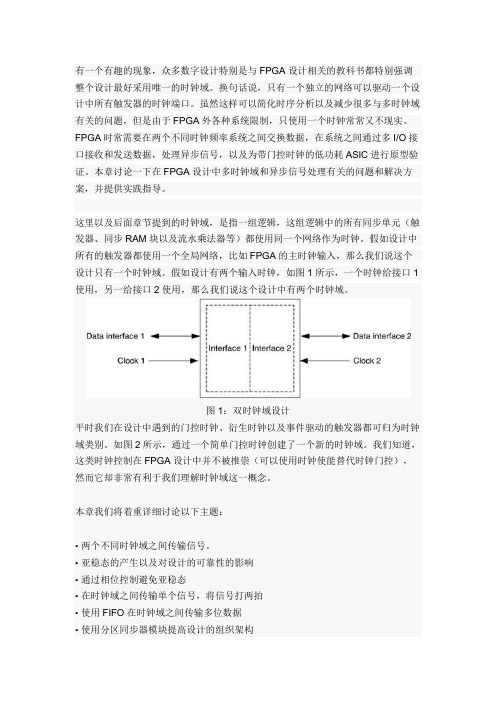
有一个有趣的现象,众多数字设计特别是与FPGA设计相关的教科书都特别强调整个设计最好采用唯一的时钟域。
换句话说,只有一个独立的网络可以驱动一个设计中所有触发器的时钟端口。
虽然这样可以简化时序分析以及减少很多与多时钟域有关的问题,但是由于FPGA外各种系统限制,只使用一个时钟常常又不现实。
FPGA时常需要在两个不同时钟频率系统之间交换数据,在系统之间通过多I/O接口接收和发送数据,处理异步信号,以及为带门控时钟的低功耗ASIC进行原型验证。
本章讨论一下在FPGA设计中多时钟域和异步信号处理有关的问题和解决方案,并提供实践指导。
这里以及后面章节提到的时钟域,是指一组逻辑,这组逻辑中的所有同步单元(触发器、同步RAM块以及流水乘法器等)都使用同一个网络作为时钟。
假如设计中所有的触发器都使用一个全局网络,比如FPGA的主时钟输入,那么我们说这个设计只有一个时钟域。
假如设计有两个输入时钟,如图1所示,一个时钟给接口1使用,另一给接口2使用,那么我们说这个设计中有两个时钟域。
图1:双时钟域设计平时我们在设计中遇到的门控时钟、衍生时钟以及事件驱动的触发器都可归为时钟域类别。
如图2所示,通过一个简单门控时钟创建了一个新的时钟域。
我们知道,这类时钟控制在FPGA设计中并不被推崇(可以使用时钟使能替代时钟门控),然而它却非常有利于我们理解时钟域这一概念。
本章我们将着重详细讨论以下主题:•两个不同时钟域之间传输信号。
•亚稳态的产生以及对设计的可靠性的影响•通过相位控制避免亚稳态•在时钟域之间传输单个信号,将信号打两拍•使用FIFO在时钟域之间传输多位数据•使用分区同步器模块提高设计的组织架构•处理ASIC验证原型里的门控时钟•建立一个单时钟模块•自动门控移除图2:通过门控时钟创建的时钟域一、跨时钟域设计中包含多时钟域,首先要解决的是在不同时钟域之间传输信号的问题。
信号跨时钟域传输将会是一个大问题,原因如下:1、信号跨时钟域传输产生的故障总是不太容易复现。
跨时钟域信号同步解决方案
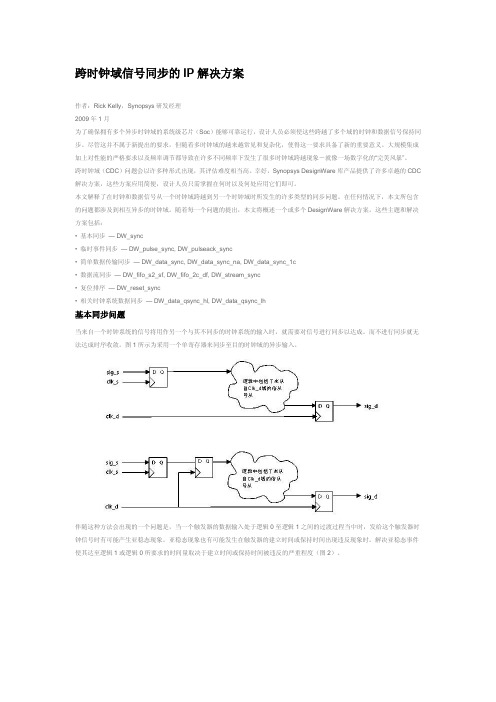
跨时钟域信号同步的IP解决方案作者:Rick Kelly,Synopsys研发经理2009年1月为了确保拥有多个异步时钟域的系统级芯片(Soc)能够可靠运行,设计人员必须使这些跨越了多个域的时钟和数据信号保持同步。
尽管这并不属于新提出的要求,但随着多时钟域的越来越常见和复杂化,使得这一要求具备了新的重要意义。
大规模集成加上对性能的严格要求以及频率调节都导致在许多不同频率下发生了很多时钟域跨越现象-就像一场数字化的―完美风暴‖。
跨时钟域(CDC)问题会以许多种形式出现,其评估难度相当高。
幸好,Synopsys DesignWare库产品提供了许多卓越的CDC 解决方案,这些方案应用简便,设计人员只需掌握在何时以及何处应用它们即可。
本文解释了在时钟和数据信号从一个时钟域跨越到另一个时钟域时所发生的许多类型的同步问题。
在任何情况下,本文所包含的问题都涉及到相互异步的时钟域。
随着每一个问题的提出,本文将概述一个或多个DesignWare解决方案。
这些主题和解决方案包括:• 基本同步— DW_sync• 临时事件同步— DW_pulse_sync, DW_pulseack_sync• 简单数据传输同步— DW_data_sync, DW_data_sync_na, DW_data_sync_1c• 数据流同步— DW_fifo_s2_sf, DW_fifo_2c_df, DW_stream_sync• 复位排序— DW_reset_sync• 相关时钟系统数据同步— DW_data_qsync_hl, DW_data_qsync_lh基本同步问题当来自一个时钟系统的信号将用作另一个与其不同步的时钟系统的输入时,就需要对信号进行同步以达成。
而不进行同步就无法达成时序收敛。
图1所示为采用一个单寄存器来同步至目的时钟域的异步输入。
伴随这种方法会出现的一个问题是,当一个触发器的数据输入处于逻辑0至逻辑1之间的过渡过程当中时,发给这个触发器时钟信号时有可能产生亚稳态现象。
fpga跨时钟域处理方法

fpga跨时钟域处理方法fpga 跨时钟域处理方法1.什么是FPGA跨时钟域处理?FPGA跨时钟域处理是指在FPGA中处理不同的时钟域的信号,把不同的时钟域的信号转换成成某种特定的格式或者特定算法,以便FPGA 能够处理这些不同的时钟域的信号。
2. FPGA跨时钟域处理的优势(1)更低的功耗,由于时钟频率较低,其功耗比信号时钟频率高的系统低得多。
(2)更高的可靠性,由于时钟频率较低,其硬件的可靠性比信号时钟频率更高。
(3)更快的切换和转换速度,在跨时钟域中,由于只需要处理少量的信号,因而切换和转换的速度会更快。
(4)更小的面积,由于少量的信号需要被转换,相应的FPAG占用的面积也会更少。
3. FPGA跨时钟域处理的实现(1)时间轴划分:第一步是将FPGA转换时钟域中需要处理的信号根据频率分类,并将其根据实际应用场景放置在不同的时间轴上,以便进行后续的处理。
(2)位转换和跨域转换:第二步是将这些处理过的信号转换为不同时钟频率域的信号,这种转换可以采用位级或字节级转换等,以便这些信号能够更好的处理。
(3)中转处理:第三步是将不同时钟频率域的信号做一个中转处理,将其转换成FPGA能够处理的信号,再对每个时钟域上的信号进行处理,完成跨时钟域处理。
4. FPGA跨时钟域处理的应用(1)通信领域:一些通信应用中会存在部分接收信号的处理只能在低频率的时钟域上完成,比如协议及协议解析。
采用FPGA跨时钟域处理,可以有效的提高系统的处理能力。
(2)信号处理领域:有不少信号处理应用一般要求高速处理,这就需要高频率的时钟域;而有些信号处理应用却完全不需要,而FPGA跨时钟域处理可以有效解决这个问题,同时又能提高系统的可靠性。
5.总结FPGA跨时钟域处理是将不同时钟域的信号转换为特定类型或特定算法,以便FPGA能够处理这些不同的时钟域的信号。
它具有更低的功耗、更高的可靠性、更快的切换和转换速度以及更小的面积等优势。
FPGA跨时钟域处理的具体步骤包括时间轴划分、位转换和跨域转换、中转处理等。
结绳法-跨时钟域

关于FPGA异步时钟采样--结绳法的点点滴滴2011-09-16 19:12:05| 分类:Verilog|举报|字号订阅一.典型方法典型方法即双锁存器法,第一个锁存器可能出现亚稳态,但是第二个锁存器出现亚稳态的几率已经降到非常小,双锁存器虽然不能完全根除亚稳态的出现(事实上所有电路都无法根除,只能尽可能降低亚稳态的出现),但是基本能够在很大程度上减小这种几率。
最后的一个D触发器和逻辑电路组成的是一个采沿(上升沿,修改一下就能采集下降沿)电路,即当第二个锁存器的输出中出现1个上升沿,那么最后的逻辑输出就会产生1个clock的高电平脉冲二.结绳法1.结绳法1:利用数据的边沿作时钟(例子中上升沿)。
(可以将脉冲无限延长,直到可以采集到数据,然后复位,要考虑产生数据的频率)。
实例1说明:这种结绳法的原理是,数据作为Din_clkA,即当数据有上升沿(0->1)时,寄存器1的输出将会稳定在高电平,此时等待clkB采样,当clkB完成采样后,寄存器4会输出高电平,若此时Din_clkA为高(为低复位时候吧?)电平,那么即可完成复位,开始下一次采样等待。
这里需要注意的是当数据来临(即上升沿)时,clkB域需要等待3个clkB才会在寄存器4输出并完成输入端的复位,所以Din如果变化较快即持续时间短于3个clkB,也就是clkA频率大于clkB的1/3,那么这时Din的变化将无法被采样到,因为clkB域需要3个clkB 才能完成采样,并且此时Din必须是低电平才能复位,并且复位后的0也要延迟3个clkB才能到达输出端.因此说,在慢时钟采样快时钟的时候,结绳法适合采样数据较少(即脉冲间隔较大)的控制信号。
即脉冲间隔Ta>3Tb;即等待3个clkB时钟后,完成复位,才允许下一个输入脉冲。
实例2说明:与实例1的区别是,这种复位更迅速,不需要等到clkA为低电平,即可完成复位。
复位后,经过3个clkB,寄存器2~4相继复位2结绳法2:利用数据作为异步复位,置位信号。
芯片fpga验证流程

芯片fpga验证流程1. 原理图设计FPGA验证的第一步是进行原理图设计,即将设计的电路拆分成逻辑门、时钟、控制器等基本部件,并将这些部件根据需要布局和布线。
由于FPGA具有可编程性,因此一般使用HDL(Hardware Description Language)语言进行设计和模拟。
2. 仿真验证在进行FPGA设计之前,需要进行仿真验证,以保证设计的正确性。
使用仿真工具对设计的电路进行模拟,可以快速检测出设计中的错误和不足之处。
仿真验证需要注意时钟同步、数据传输、芯片会场布局等问题。
3. 物理验证在完成电路的设计后,需要进行物理验证。
其中包括板级布局、芯片级布局、测试访问机制等物理设计。
在这一阶段中,需要考虑布局对时序、信号完整性和电磁干扰等方面的影响。
4. 静态时序分析静态时序分析是验证在各种情况下FPGA系统的信号传输时间是否能满足硬性时序要求的一项关键任务。
这一过程通常包括设置时钟时延、根据门级网络实现和约束文件添加关键路径等。
5. 时钟分析时钟是FPGA设计中非常重要的元素,“时钟域过渡捕捉”是指当信号从一个时钟域转到另一个时钟域时,捕捉到信号的过程。
在FPGA设计过程中,出现时钟域过渡捕捉错误会导致系统不可预测的行为,因此时钟分析是不可或缺的一步。
6. 功耗分析FPGA芯片设计中,功耗一般分为静态功耗和动态功耗。
在FPGA设计的过程中,需要对功耗进行有效控制,以确保芯片设计能够满足功耗规格和限制。
这一步骤的目标是将功耗保持在可行范围内,同时确保电路的性能和功能稳定。
7. 芯片测试和验证芯片测试和验证是FPGA设计流程中的最后一步,用于确定芯片设计的正确性、性能和可靠性。
在芯片测试和验证过程中,需要进行硬件测量和软件测试,依据测试结果对设计进行修改和纠正,直到达到设计要求。
以上就是FPGA验证流程的主要步骤。
在实际工作中,还需要根据实际情况进行调整和修改,以达到最佳的验证效果。
跨时钟域处理方法
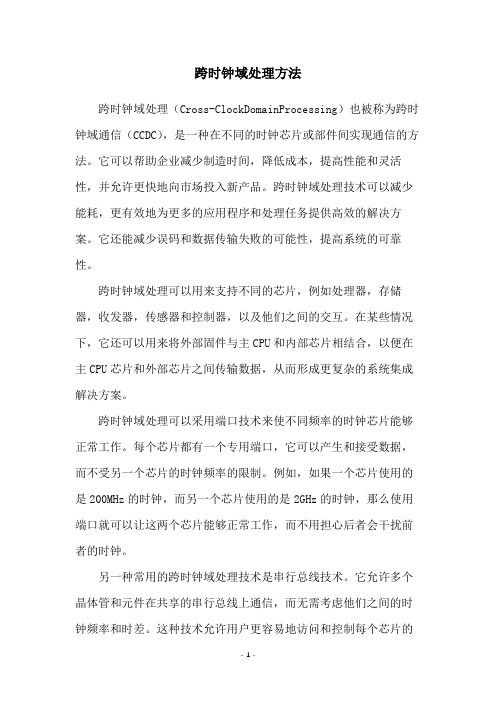
跨时钟域处理方法跨时钟域处理(Cross-ClockDomainProcessing)也被称为跨时钟域通信(CCDC),是一种在不同的时钟芯片或部件间实现通信的方法。
它可以帮助企业减少制造时间,降低成本,提高性能和灵活性,并允许更快地向市场投入新产品。
跨时钟域处理技术可以减少能耗,更有效地为更多的应用程序和处理任务提供高效的解决方案。
它还能减少误码和数据传输失败的可能性,提高系统的可靠性。
跨时钟域处理可以用来支持不同的芯片,例如处理器,存储器,收发器,传感器和控制器,以及他们之间的交互。
在某些情况下,它还可以用来将外部固件与主CPU和内部芯片相结合,以便在主CPU芯片和外部芯片之间传输数据,从而形成更复杂的系统集成解决方案。
跨时钟域处理可以采用端口技术来使不同频率的时钟芯片能够正常工作。
每个芯片都有一个专用端口,它可以产生和接受数据,而不受另一个芯片的时钟频率的限制。
例如,如果一个芯片使用的是200MHz的时钟,而另一个芯片使用的是2GHz的时钟,那么使用端口就可以让这两个芯片能够正常工作,而不用担心后者会干扰前者的时钟。
另一种常用的跨时钟域处理技术是串行总线技术。
它允许多个晶体管和元件在共享的串行总线上通信,而无需考虑他们之间的时钟频率和时差。
这种技术允许用户更容易地访问和控制每个芯片的信号,而无需考虑时钟延时的问题。
最后,要注意的是,跨时钟域处理技术的实施必须保证其精确性和可靠性。
这可能会需要使用适当的补偿和专用控制系统,以确保系统中的所有芯片能够正常工作并保持稳定性,从而实现最佳性能和可靠性。
总之,跨时钟域处理是一种令人印象深刻的技术,可以有效地减少成本,并提高系统性能,提高可靠性和性能。
此外,它还可以帮助更快地推向市场新产品,提高市场竞争力。
企业应该利用跨时钟域处理技术,以更有效的方式来解决问题,实现更多的目标。
跨时钟域问题处理

跨时钟域问题处理在FPGA设计中,不太可能只⽤到⼀个时钟。
因此跨时钟域的信号处理问题是我们需要经常⾯对的。
跨时钟域信号如果不处理的话会导致2个问题:(1) 若⾼频率时钟区域输出⼀个脉冲信号给低频率时钟区域,则该脉冲很有可能⽆法被采样到,⽰意图如下,clk2根本采样不到pulse,但是从原理上来说,低频时钟是⽆法完全去采样⾼频信号的,这⾥⾯⼀定会丢失信息。
这是⽆法避免的。
(2) 亚稳态问题在说明亚稳态之前,我们需要先了解什么是建⽴时间和保持时间建⽴时间:在时钟沿到来前,被采样信号应该提前⼀段时间就进⼊稳定状态,这个时间称为建⽴时间保持时间:在时钟沿到来后,被采样的信号应该保持稳定⼀段时间,这个时间称为保持时间⽽亚稳态就是建⽴时间和保持时间不满⾜导致的。
如下图所⽰,就是建⽴时间不满⾜,造成dout是个不确定值,即亚稳态。
很多新⼈以为亚稳态仅仅是逻辑上的障碍,其实亚稳态是实实在在的电路上的问题。
模拟电路中,三极管主要⼯作在其放⼤区间,⽽在数字电路却是要⼯作在截⾄态。
亚稳态⾮常类似模拟电路中的放⼤态,这个状态将使得器件的输出电流被放⼤,如果这个状态被传递,那么将导致更多的电路处在放⼤电路的⼯作状态中,这将引起巨⼤的电流和功耗,甚⾄烧毁芯⽚,所以,跨时钟域是⼀定会出现亚稳态的,但是我们必须要把亚稳态控制在⼀个很⼩的范围内。
这就是为什么要在其后⾯再⽤⼀个寄存器的原因。
它的功能就是把亚稳态仅仅限制在那⼀个寄存器的⼩区域。
亚稳态会造成严重的后果。
就像将军发命令⼀样,若其发出的是⼀个亚稳态的命令,⼠兵A可能判定这个命令为进攻,⼠兵B可能判定这个命令为撤退,这将引起极⼤的混乱。
解决⽅案:1,握⼿操作(⾼频信号要进⼊低频时钟域)针对问题1中所描述的情况,即快时钟域传递⼀个脉冲信号到慢时钟域,慢时钟域很有可能采样不到该脉冲。
这时就需要采⽤握⼿操作来解决了。
⾸先,快时钟域应该将脉冲信号转换为⼀个持续信号,慢时钟域采样到该持续信号后,返回⼀个反馈信号,告知块时钟域将持续信号拉低。
CDC跨时钟域处理

单信号:慢时钟域快时钟域
• 如果我们仍然使用同样的参数,则第2级触发器 的MTBF为9.57 *10^9(years) 。这个值已经足以 使系统长期稳定。
总结
• 问题1:为何直接对异步信号进行采样会不稳 定? • 问题2:要使用几级寄存器进行同步最合适? • 问题3:同步寄存器电路可以防止亚稳态产生 吗?
单信号:快时钟域慢时钟域
• 当快时钟域的信号跳变太快,导致目标时 钟域无法采样时,应如何处理? • 1.拉伸快时钟域信号的脉冲宽度使其足以被 正确采样 • 2.结绳法(脉冲同步器)
① 脉冲拉伸法
脉冲拉伸同步电路
② 结绳法 • 信号从快时钟域向慢时钟域过渡时,慢时钟 将可能无法对变化太快的信号实现正确采样。
• “结绳法”原理:将快时钟信号的脉冲周期 延长,等到慢时钟同步采样后再“解绳”还 原为原来的脉冲周期宽度。
单信号:快时钟域慢时钟域 结绳同步电路
Synopsys DW库内的推荐电路
脉冲同步器使用规则 • 1. 总线数据不能对每个信号单独使用同步 器,会导致数据无法同时有效。 • 2.输入的信号必须是单周期脉宽,否则无法 成功进行“结绳”操作 • 3.输入脉冲之间的最小间隔必须等于两个同 步器时钟周期。如果输入脉冲相邻太近, 则同步器就不能检测到每个脉冲。
主要内容
• • • • 1.单一信号跨时钟域处理 2.总线数据的跨时钟域处理 3.数据流的跨时钟域处理 4.相关时钟系统数据同步
相关时钟系统
• 如果两个时钟分别为同一个源时钟的分频或倍 频时钟,则称为相关时钟 • 相关时钟的相位是可以通过工具进行对齐的 • 跨越的时钟域为相关时钟,这时可以用更简便 的处理方式,简化同步电路
工艺器件映射
• 在DC将两个触发器映射到一个目标库上时,综 合工具会选择能够满足时序限制条件的最小面 积的单元,而不是对同步最好的触发器 • 因此通常想要通过手动方式或通过脚本方式用 已知的“亚稳态强化”触发器来替代这些触发 器 • 自DC2009版本开始,可以指定一个或多个“亚 稳态强化”触发器用在上述DW库中的CDC组件。 • 方法:通过将相关器件赋给 “synlib_preferred_ffs”变量实现特定寄存器的 调用
FPGA_跨时钟域

跨时钟域4.1跨时钟域处理(20160620)时钟对于FPGA就像我们的心脏,时刻控制着“跳动”的频率以及“血液”的流速;时钟域好比通过心脏的血液血型,不同血型的血液会产生排斥作用。
在设计中建议时钟越少越好,好比于人有两个甚至更多的心脏,其内脏工作将会多么混乱。
但是某些情况下多时钟又不可避免,比如从FPGA外部输入的数据,其自带有个随路时钟,数据终归要在FPGA内部时钟域下处理,这来自外部的“血液”如何处理才能与内部的“血液”融合呢?配对及转换工作则是必不可少的,这就引入本节的主题:跨时钟域处理(Clock Domain Crossing):跨时钟域处理需要两方面的工作:1、设计者处理;2、FPGA工具(Vivado)处理。
1.设计者处理首先讲解一下如果不进行跨时钟域处理,会出现什么问题呢?如图1所示路径,QA属于CLKA时钟域的数据输出,另一个时钟CLKB去捕获节点REG A 的输出QA,假定CLKA与CLKB是异步时钟,它们之间的相位并不固定,因此捕获过程中可能会出现建立冲突(setup violation)和保持冲突(hold violation),如图2所示,左右分别为发生建立冲突和保持冲突的情况。
图1图2当冲突出现时(我感觉整个人都不好了),会发生什么事情呢?在发生建立冲突或者保持冲突,捕获节点(REG B)会处于一个不定的状态,正常的状态是高电平或者低电平,而此时的状态停留在高电平和低电平的中间,无效的电平X,称这个状态为亚稳态。
如图3所示,捕获节点输出保持在亚稳态,可能在整个时钟周期内都保持在亚稳态,由于不正确的状态,其后连接的逻辑在功能实现上就会出现问题,比如一个判断信号上升沿的逻辑,通常判断D==HIGH&&D_PREV==LOW(D为信号当前电平状态,D_PREV为信号上个时钟的电平状态)是否成立,而发生亚稳态时则D_PREV==X,这个上升沿将会错过。
因此,加入跨时钟域处理设计是必须的。
跨时钟域信号同步方法6种
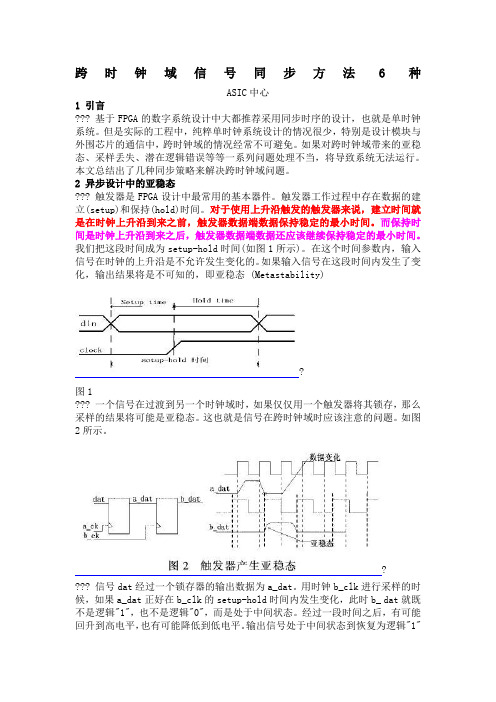
跨时钟域信号同步方法6种ASIC中心1 引言??? 基于FPGA的数字系统设计中大都推荐采用同步时序的设计,也就是单时钟系统。
但是实际的工程中,纯粹单时钟系统设计的情况很少,特别是设计模块与外围芯片的通信中,跨时钟域的情况经常不可避免。
如果对跨时钟域带来的亚稳态、采样丢失、潜在逻辑错误等等一系列问题处理不当,将导致系统无法运行。
本文总结出了几种同步策略来解决跨时钟域问题。
2 异步设计中的亚稳态??? 触发器是FPGA设计中最常用的基本器件。
触发器工作过程中存在数据的建立(setup)和保持(hold)时间。
对于使用上升沿触发的触发器来说,建立时间就是在时钟上升沿到来之前,触发器数据端数据保持稳定的最小时间。
而保持时间是时钟上升沿到来之后,触发器数据端数据还应该继续保持稳定的最小时间。
我们把这段时间成为setup-hold时间(如图1所示)。
在这个时间参数内,输入信号在时钟的上升沿是不允许发生变化的。
如果输入信号在这段时间内发生了变化,输出结果将是不可知的,即亚稳态 (Metastability)?图1??? 一个信号在过渡到另一个时钟域时,如果仅仅用一个触发器将其锁存,那么采样的结果将可能是亚稳态。
这也就是信号在跨时钟域时应该注意的问题。
如图2所示。
???? 信号dat经过一个锁存器的输出数据为a_dat。
用时钟b_clk进行采样的时候,如果a_dat正好在b_clk的setup-hold时间内发生变化,此时b_ dat就既不是逻辑"1",也不是逻辑"0",而是处于中间状态。
经过一段时间之后,有可能回升到高电平,也有可能降低到低电平。
输出信号处于中间状态到恢复为逻辑"1"或逻辑"0"的这段时间,我们称之为亚稳态时间。
???? 触发器进入亚稳态的时间可以用参数MTBF(Mean Time Between Failures)来描述,MTBF即触发器采样失败的时间间隔,表示为:?其中fclock表示系统时钟频率,fdata代表异步输入信号的频率,tmet代表不会引起故障的最长亚稳态时间,C1和C2分别为与器件特性相关的常数。
跨时钟域信号同步解决方案

跨时钟域信号同步的IP解决方案作者:Rick Kelly,Synopsys研发经理2009年1月为了确保拥有多个异步时钟域的系统级芯片(Soc)能够可靠运行,设计人员必须使这些跨越了多个域的时钟和数据信号保持同步。
尽管这并不属于新提出的要求,但随着多时钟域的越来越常见和复杂化,使得这一要求具备了新的重要意义。
大规模集成加上对性能的严格要求以及频率调节都导致在许多不同频率下发生了很多时钟域跨越现象-就像一场数字化的―完美风暴‖。
跨时钟域(CDC)问题会以许多种形式出现,其评估难度相当高。
幸好,Synopsys DesignWare库产品提供了许多卓越的CDC 解决方案,这些方案应用简便,设计人员只需掌握在何时以及何处应用它们即可。
本文解释了在时钟和数据信号从一个时钟域跨越到另一个时钟域时所发生的许多类型的同步问题。
在任何情况下,本文所包含的问题都涉及到相互异步的时钟域。
随着每一个问题的提出,本文将概述一个或多个DesignWare解决方案。
这些主题和解决方案包括:• 基本同步— DW_sync• 临时事件同步— DW_pulse_sync, DW_pulseack_sync• 简单数据传输同步— DW_data_sync, DW_data_sync_na, DW_data_sync_1c• 数据流同步— DW_fifo_s2_sf, DW_fifo_2c_df, DW_stream_sync• 复位排序— DW_reset_sync• 相关时钟系统数据同步— DW_data_qsync_hl, DW_data_qsync_lh基本同步问题当来自一个时钟系统的信号将用作另一个与其不同步的时钟系统的输入时,就需要对信号进行同步以达成。
而不进行同步就无法达成时序收敛。
图1所示为采用一个单寄存器来同步至目的时钟域的异步输入。
伴随这种方法会出现的一个问题是,当一个触发器的数据输入处于逻辑0至逻辑1之间的过渡过程当中时,发给这个触发器时钟信号时有可能产生亚稳态现象。
信号跨时钟域的几种方法
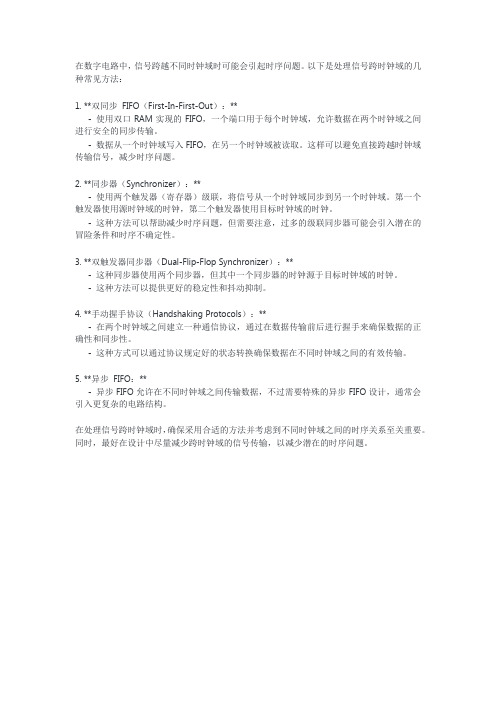
在数字电路中,信号跨越不同时钟域时可能会引起时序问题。
以下是处理信号跨时钟域的几种常见方法:1. **双同步FIFO(First-In-First-Out):**- 使用双口RAM实现的FIFO,一个端口用于每个时钟域,允许数据在两个时钟域之间进行安全的同步传输。
- 数据从一个时钟域写入FIFO,在另一个时钟域被读取。
这样可以避免直接跨越时钟域传输信号,减少时序问题。
2. **同步器(Synchronizer):**- 使用两个触发器(寄存器)级联,将信号从一个时钟域同步到另一个时钟域。
第一个触发器使用源时钟域的时钟,第二个触发器使用目标时钟域的时钟。
- 这种方法可以帮助减少时序问题,但需要注意,过多的级联同步器可能会引入潜在的冒险条件和时序不确定性。
3. **双触发器同步器(Dual-Flip-Flop Synchronizer):**- 这种同步器使用两个同步器,但其中一个同步器的时钟源于目标时钟域的时钟。
- 这种方法可以提供更好的稳定性和抖动抑制。
4. **手动握手协议(Handshaking Protocols):**- 在两个时钟域之间建立一种通信协议,通过在数据传输前后进行握手来确保数据的正确性和同步性。
- 这种方式可以通过协议规定好的状态转换确保数据在不同时钟域之间的有效传输。
5. **异步FIFO:**- 异步FIFO允许在不同时钟域之间传输数据,不过需要特殊的异步FIFO设计,通常会引入更复杂的电路结构。
在处理信号跨时钟域时,确保采用合适的方法并考虑到不同时钟域之间的时序关系至关重要。
同时,最好在设计中尽量减少跨时钟域的信号传输,以减少潜在的时序问题。
xilinx 跨时钟域设计 概述及解释说明
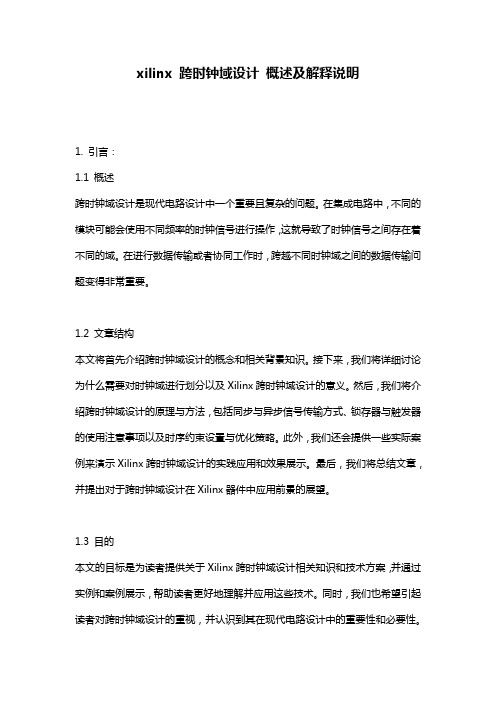
xilinx 跨时钟域设计概述及解释说明1. 引言:1.1 概述跨时钟域设计是现代电路设计中一个重要且复杂的问题。
在集成电路中,不同的模块可能会使用不同频率的时钟信号进行操作,这就导致了时钟信号之间存在着不同的域。
在进行数据传输或者协同工作时,跨越不同时钟域之间的数据传输问题变得非常重要。
1.2 文章结构本文将首先介绍跨时钟域设计的概念和相关背景知识。
接下来,我们将详细讨论为什么需要对时钟域进行划分以及Xilinx跨时钟域设计的意义。
然后,我们将介绍跨时钟域设计的原理与方法,包括同步与异步信号传输方式、锁存器与触发器的使用注意事项以及时序约束设置与优化策略。
此外,我们还会提供一些实际案例来演示Xilinx跨时钟域设计的实践应用和效果展示。
最后,我们将总结文章,并提出对于跨时钟域设计在Xilinx器件中应用前景的展望。
1.3 目的本文的目标是为读者提供关于Xilinx跨时钟域设计相关知识和技术方案,并通过实例和案例展示,帮助读者更好地理解并应用这些技术。
同时,我们也希望引起读者对跨时钟域设计的重视,并认识到其在现代电路设计中的重要性和必要性。
通过本文的阅读,读者将能够掌握Xilinx跨时钟域设计的基本原理与方法,并应用于实际工程项目中,提高电路的可靠性和性能。
2. 跨时钟域设计概述:2.1 什么是时钟域:时钟域是指由一个主时钟信号驱动的一组逻辑电路。
在数字电路设计中,系统通常包含多个时钟域,每个时钟域都有独立的主时钟信号。
由于不同时钟域之间存在着频率和相位差异,因此跨越不同时钟域的信号传输需要特殊的设计策略和技术支持。
2.2 时钟域划分的必要性:在复杂的数字系统中,为了提高系统性能和可靠性,常常需要将整个系统划分为多个独立的时钟域。
这种划分可以使各模块按照不同的时间精度进行操作,并且能够减少信号互联、功耗消耗以及故障引入等问题。
同时,通过合理地划分和管理时钟域,能够降低系统开发复杂度,并确保数据在稳定状态下进行正确传输。
FPGA软件自动化验证平台设计与实践

FPGA软件自动化验证平台设计与实践费亚男;周辉;朱伟杰【摘要】目前,航天任务急剧增多,研制周期大大缩短,FPGA的应用呈阶梯式增长,提高FPGA软件的测试效率成为新的挑战;验证平台的搭建是进行FPGA测试的前提条件,而验证平台的好坏直接影响测试效率和质量;为了提高测试效率,设计搭建了基于Make-file脚本的自动化验证平台,可在该平台上进行FPGA软件静态测试和动态测试,覆盖了目前航天型号FPGA软件测试的全部类型,实验结果表明该平台的应用能够有效地缩短测试时间,并保证测试质量.【期刊名称】《计算机测量与控制》【年(卷),期】2016(024)005【总页数】4页(P139-142)【关键词】FPGA软件测试;自动化;验证平台;Makefile脚本【作者】费亚男;周辉;朱伟杰【作者单位】北京航天自动控制研究所,北京 100854;北京航天自动控制研究所,北京 100854;北京航天自动控制研究所,北京 100854【正文语种】中文【中图分类】TP306FPGA作为可编程逻辑器件,通过用户自定义编写VHDL程序或者Verilog程序进行配置,实现用户所需功能。
但是一旦编写的程序存在缺陷,比如状态机的跳转条件错误、对输入信号未进行滤波处理、计数器的计数值产生溢出等,都会导致FPGA 输出信号逻辑状态错误,无法实现预期的设计,严重的会影响系统功能,致使系统运行紊乱,最后造成重大事故,在财力物力上损失惨重。
为提高FPGA 运行的可靠性,需对其进行测试[3]。
目前,FPGA主要测试方法为:基于软环境的FPGA 测试[4]和基于ATE的FPGA 测试。
其中基于软环境的FPGA测试按照是否要运行程序分为静态测试和动态测试,动态测试又可分为黑盒测试和白盒测试。
这种测试方法的优点是,不受硬件环境影响,测试结果稳定性好,测试类型齐全,并且可进行异常测试。
缺点是,环节太多为测试工作带来极大不便,并且自动化程度低,测试花费时间长。
vivado跨时钟域约束

vivado跨时钟域约束Vivado是一款由Xilinx公司开发的集成电路设计工具,用于设计和实现FPGA(现场可编程门阵列)和SoC(片上系统)等数字电路。
在FPGA设计中,时钟域划分和时钟约束是非常重要的步骤,特别是在跨时钟域的设计中。
跨时钟域设计是指在一个FPGA设计中存在多个时钟域,不同的时钟域之间存在时序约束和时钟域间的数据传输。
由于不同时钟域之间的时钟频率和相位存在差异,因此需要进行跨时钟域约束来确保数据的正确传输和时序的满足。
在Vivado中,可以使用set_clock_groups命令来定义时钟组,以及使用set_false_path和set_multicycle_path等命令来设置跨时钟域约束。
我们需要将不同的时钟信号分组,形成时钟组。
在时钟组中,所有时钟信号都需要满足相同的时钟约束。
我们可以使用set_clock_groups命令来定义时钟组,如下所示:set_clock_groups -asynchronous -group {clk1 clk2 clk3}上述命令表示将clk1、clk2和clk3形成一个时钟组,并且时钟之间是异步的。
这意味着在时钟组中的时钟之间不需要保持任何特定的时序关系。
除了时钟组的设置,还需要设置跨时钟域的路径约束。
在跨时钟域的设计中,数据的传输需要经过时钟域边界,因此需要设置路径约束来确保数据的正确传输。
在Vivado中,可以使用set_false_path命令来设置不需要进行时序分析的路径,如下所示:set_false_path -from [get_clocks clk1] -to [get_clocks clk2]上述命令表示将clk1到clk2之间的路径设置为false path,不进行时序分析。
这样可以避免时序分析器对这条路径进行时序优化,从而减少时序分析的复杂性。
除了set_false_path命令,还可以使用set_multicycle_path命令来设置跨时钟域的多周期路径。
- 1、下载文档前请自行甄别文档内容的完整性,平台不提供额外的编辑、内容补充、找答案等附加服务。
- 2、"仅部分预览"的文档,不可在线预览部分如存在完整性等问题,可反馈申请退款(可完整预览的文档不适用该条件!)。
- 3、如文档侵犯您的权益,请联系客服反馈,我们会尽快为您处理(人工客服工作时间:9:00-18:30)。
Advanced Verification White Paper Five Steps to QualityCDC VerificationPing Yeung Ph.D.Mentor GraphicsCDC synchronizers are used to reduce the probability of metastable signals. Taking unpredictable metastable sig-nals and creating predictable behavior, they prevent metastable values from reaching the receiving clock domain.Metastability EffectsEven when proper CDC synchronizers are used for all clock-domain crossings and all CDC protocols are cor-rectly implemented, metastability inevitably leads to unpredictable cycle-level timing [4, 5]. Traditional RTL simulation does not model metastability, therefore, it cannot be used to find functional problems that may arise when metastability manifests in hardware. We are going to show two scenarios in which the cycle-level timing of RTL simulation differs from the cycle-level timing of the actual hardware in the presence of metastability.In Figure 3, the incoming CDC signal, cdc_d , violates the register setup time. Although it is sampled correctly in RTL simulation, the register is metastable and the output settles to 0. As a result, the hardware transition is delayed by one cycle.Figure 2: A two-register CDC synchronizer.Figure 4: Hold time violation: hardware transition is advanced by one cycle.Figure 3: Setup time violation: hardware transition isdelayed by one cycle.In Figure 4, the incoming CDC signal, cdc_d, violates the register hold time. In RTL simulation, it is not sam-pled until the next cycle. However, the register is metastable and the output settles to 1. As a result, the hardware transitions one cycle before simulation.CDC VerificationMany designers know that metastability can be controlled using synchronizers on CDC signals. The most com-mon solution is to use synchronizers made up of two D flip-flops (2-DFF), or more, in sequence to dramatically increase the mean time between failure (MTBF) of the crossings. It is important to point out that simply ensur-ing the presence of synchronizers on the appropriate signals, while necessary, is not nearly sufficient. There are three different aspects of CDC verification that must be carefully addressed:•Structural verification. Each synchronizer must have the correct structure for the type of signal being sent across clock domains. For example, a 2-DFF synchronizer is usually the best solution for single-bit signals but should not be used for multi-bit signals unless they are gray-coded to ensure that only one bit changes at a time [1, 2]. Multi-bit signals may be synchronized across domains using a separate control signal, an asynchronous FIFO, or other methods. Also, there should be no combinational logic inside or before a synchronizer.•Protocol verification. Each synchronizer must follow a set of rules, called a transfer protocol, to ensure that the CDC signal is properly transferred across clock domains. For example, even the simplest 2-DFF synchronizer requires that the transmitting signal be held stable long enough to guarantee that it is captured in the receiving domain. This may not occur if the transmitting clock is faster than the receiving clock. Synchronization structures for multi-bit signals require more complex protocol checks [2, 3]. When CDC transfer protocols are violated, an error may not occur in simulation but will eventually occur in real hardware.•Metastability verification. Problems associated with the reconvergence of CDC signals must be avoided. Reconvergence occurs when multiple signals are synchronized separately from one clock domain to another and then used by the same logic in the receiving domain (Figure 5). If that logic assumes a timing relationship between the signals, the design is not tolerant of metasta-Figure 5: Reconvergence of CDC signals.running CDC verification at the chip-level is not idealas there are too many behavioral models. For this reason, designs with the RTL representation arebest suited for CDC verification. All multiple-bit regis-ters and buses can be identified explicitly. As CDCrequirements for data and control signals are different,they can be analyzed separately. Conversely, with a gate-level representation, all buses have been synthesized intosingle-bit wires. It is impossible to distinguish data fromcontrol signals. Thus, only a subset of the CDC schemeis applicable.In addition, knowledge of the internal structure of thedesign is essential for successful CDC verification.Performing CDC analysis on third-party IP blocks orlegacy designs are not very beneficial. Without designknowledge, you may not be able to confirm the bugs orfilter violations. You need access to the original design-er; knowledge of the design is essential to understandthe results.Document CDC requirements This step is important. It has the biggest impact on the quality of the result. You need to ensure that your CDC verification will be aware of all relevant design characteristics, clock relationships, and the external environ-ment. Although a set of CDC rules have been defined already in the tool, with this additional information, extra design rules and filters will be activated. As a result, the results will be more accurate and thorough. You should define the operational modes of the design, outline the clock structures, document the domains for interface sig-nals, and determine the acceptable or unacceptable synchronization rules.•Define operational modes . Some users may be interested in verifying that all registers are driven by only the test clock when the design is in scan mode. However, in general, we want to perform CDC verification when the design is in normal operation. You should disable the non-functional modes (i.e., test, BIST, JTAG , etc.)and define the meaningful operational modes and configurations for the tool (Figure 8). In many cases, some parts of a design can be put into sleep or powered-down mode. The combinations can be countless. Hence, it is important to focus CDC verification on the important combinations.•Outline clock structures . For a multiple-clock design, the primary clocks, the clock distribution structure, and the internal clock generators, dividers, and clock gating schemes are important and should be documented. The 0-In CDC tool [7] can understand these structures and extract the clock tree information automatically. It is useful to verify the original design intent with the extracted clock structures. Only crossings between asynchronous clocks should be analyzed, and there may be clock gating conditions that need to be set up properly. As the number of CDC paths Figure 7: Blocks suitable for running CDC verification are A, C, and D.Figure 8: Define meaningful modes for CDC verification.is proportional to the number of clock domains, it is much more efficient to limit analysis to the relevant clock domains only.•Document interface signals.CDC verification will not check an interface signal if it does not know which clock domain it is coming from or fanning out to. You should group signals for each functional interface and clock domain and explicitly identify any input signals that are asynchronous to all clock domains. The tool will then determine whether input signals require synchronization before use. Asynchronous and synchro-nous reset signals should be labeled separately. The synchronization schemes used for reset signals are dif-ferent from normal interface signals.•Define synchronization rules.Some companies require all CDC signals to be synchronized with a particular CDC scheme (for instance, 3-level DFFs) or with a custom synchronization cell. The 0-In CDC tool [7] rec-ognizes many CDC schemes. It is important to review those schemes first. Then you can categorize the legal or illegal synchronization schemes, turn off the unused schemes and capture the characteristics of the syn-chronization cells or modules.Some detail-oriented designers will specify the clock domain information and capture the CDC paths in the design document. This is a practice we encourage. With this information, you can pay special attention to the specified CDC paths to ensure they are well covered.Formalize known exceptionsIt is not unusual that a simple CDC error will generate a lot of violations, especially when the CDC signal fans out to a large number of asynchronous domains. Hence, we want to identify upfront all registers that can be con-sidered stable and do not require synchronization. This is especially true for configuration registers, status regis-ters, or control registers that are programmed by software before the design enters into normal operation. Usually this information is in the design specification. Often these control registers all reside within a single module or follow a common naming scheme. It is useful to leverage this information for CDC verification.In addition to registers, some of the interface or internal signals are known to be stable during normal opera-tion; for example, the internally generated reset signals, the power-down signals, the chip select, and functional enable and disable signals. These are all useful in improving the efficacy of CDC verification. Finally, in previ-ous revisions of the chip, there may be known CDC bugs and issues found using manual or gate-level method-ologies.. These are painful lessons which should be captured in the verification plan. During CDC verification, you should ensure that those CDC paths are analyzed and that all problems were fixed correctly.Define coverage goalsBased on our experience, CDC paths are poorly verified by traditional functional verification because, in a functional simulation environment, the clock periods are defined to be constants, the clock skews and relation-ships are fixed, and the clock signals are well-behaved without any buffer or propagation delay. To ensure metastability effects on CDC paths are better verified, companies use various ad-hoc approaches. Some ran-domly reduce or prolong the clock periods. Some randomly change the skews and relationships among multiple asynchronous clocks.Regardless of the technique used, when verifying CDC transfer protocols in simulation, it is important to moni-tor protocol coverage to make sure the CDC paths are adequately verified. This can be done by using a checker from an assertion library [9, 10, 11] to capture the semantics of the protocol. Checkers collect coverage infor-mation to ensure that each CDC protocol is fully exercised. Insufficient coverage means that the design may contain undiscovered bugs.CDC Handshake:- Assertion:i.multiple requests violationii.acknowledge without request violationiii.request drop violationiv.acknowledge timeout violation- Coverage:i.#request assertedii.#acknowledge assertedCDC FIFO:- Assertion:i.FIFO overflow violationii.FIFO underflow violationiii.Simultaneous push and pop violation- Coverage:i.#push assertedii.#pop assertediii.maximum FIFO entryYou start by itemizing the protocols used in the CDC paths, ordering them from most important to least, and identifying the protocols that require coverage. For each CDC protocol, you will determine the assertion and coverage items, as in the code shown above. To measure how well your simulation is verifying the metastability effects, you should also monitor the alignments of the RX and the TX clocks.Select a verification strategyYou may choose to perform exhaustive verification on each individual block or use a hierarchical approach on the entire top-level of a chip. The top-level represents the highest functional hierarchy of the design, excluding the pad ring, the test logic, the power controls, etc. You may be looking for a known bug or hunting for a prob-lem that has appeared in the lab. The strategies you choose will determine how to run your CDC analysis tools. Based on our experience, there are four common strategies•Block-level verification.During block-level design, static analysis of the CDC structures should be run before checking in the RTL code. This ensures strict compliance with CDC schemes. If issues are discov-ered, they can be identified and debugged quickly at this level. The generated CDC protocol monitors can also be used with block-level functional verification methodologies, such as formal verification [8] and simulation. These ensure that CDC protocols are followed without any data loss.•Top-level verification. During top-level integration, static analysis of the CDC structures should be re-run to check the new CDC signals created when multiple blocks are integrated together. The number of CDC signals goes up exponentially at the top-level. Hence, it is important to follow the five-step planning processdescribed above. For large and complex designs, especially ones with a lot of IP modules, a hierarchical veri-fication approach can be used. The generated CDC protocol monitors should be included in the regression for system-level functional verification.•Bug hunting and triage. This is performed to identify known or suspected CDC issues in the design. It is important to distinguish timing from CDC issues. Timing issues tend to cause the chip to fail consistently. By changing the frequencies of the clocks or of some of the signals, the problems may disappear permanently. On the other hand, as metastability is unpredictable, CDC problems will cause the chip to fail randomly. Based on our experience, it is extremely difficult to look for CDC issues at the system or chip level. There are just too many potential candidates. Hence, the first task is to narrow down the problem to the block or subsystem level.You should focus on blocks with asynchronous clock domains. Blocks with CDC reconvergence are especially suspicious. The random delays from different CDC paths may cause the data to be sampled incorrectly or cor-rupted completely. Once the candidate blocks are identified, the block-level verification strategy can be applied.•Targeting coverage.This can be an extension of the block-level or top-level verification strategy. The goal is to ensure that all CDC protocols have been fully exercised and that the metastability effects are fully verified on all CDC paths. The coverage on the CDC protocols monitors should be examined and additional tests created to fill any coverage holes. Once the bug rate of system-level regression has stabilized, metastability can be injected into simulation. Metastability effects will change the timing of the CDC paths. If the block is not designed to handle the random delays of the CDC paths, it may fail functionally. To make debugging easier, it is better to start with a representative subset of the regression.In the next two sections, we will elaborate on the two most commonly used strategies: block-level andtop-level verification.•Correctly implemented synchronizers•Missing and incorrectly implemented synchronizers•Complex synchronizers that require protocol verification•Potential reconvergence problemsAt this level, since the design description contains a lot of modules with a lot of asynchronous clock domains, most of the CDC paths fall into the complex and reconvergence categories. The GUI environment is particularly useful in this case as the CDC path may span multiple levels of hierarchy and several modules.2. Run protocol verification with simulation. With the testbench environment already available for functional veri-fication, we can run the CDC protocol monitors within the simulation environment. These monitors ensure that the CDC signal is stable when going from the TX to the RX domain; the multiple-bit CDC data is gray-coded, or it is stable when it is sampled. Any assertion failure caught by the monitors means that the CDC protocol is vio-lated and should be fixed. Functional simulation gives lengthy margins for CDC signals. They tend to be suffi-ciently stable when going through the clock domains. This approach does a poor job stressing the timing of the CDC paths. Hence, when running CDC protocol monitors with functional simulation, it is important to examine the corner case coverage of the protocol monitors. Monitors which pass should have adequate coverage when the results from the whole regression suite are merged together. In order to stress the timing of the CDC paths explic-itly, we can add some direct tests into the regression suite. With a constrained-random verification environment, we can tighten the timing of the stimulus generator.3. Run metastability verification with simulation and effect injection.If your design contains potential reconver-gence violations that cannot be easily waived after manual inspection, the 0-In CDC tool [7] can be used to iden-tify reconvergence problems by injecting metastability effects dynamically. In simulation, metastability effect injectors will change the delays through synchronizers. As a result, any logic that assumes a fixed timing rela-tionship between the outputs of the synchronizers is likely to fail. Running simulation with the effect injectors is the most cost effective way to imitate CDC metastability effects during functional verification. It enables any potential problems to be discovered quickly, before any hardware is built.Debugging CDC ViolationsIn this section, we will describe a few common CDC violations and the techniques you can use to determine whether they are real design issues or not.Missing synchronizer violationAn unsynchronized CDC signal is the most common violation reported during structural verification. For instance, in Figure 11, depending on the clock frequency, the RX register may not be able to sample its input reliability. This is a real problem. In other cases, violation are due to the following exceptions.References1. Clifford E. Cummings, “Synthesis and Scripting Techniques for Designing Multi-Asynchronous Clock Designs,” SNUG-2001. Downloadable from /papers2. Tai Ly, “The Need for an Automated Clock Domain Crossing Verification Solution,” White Paper, Downloadable from /fv3. Chris Kwok, et al, “Using Assertion-Based Verification to Verify Clock Domain Crossing Signals,” DVCon 20034. Tai Ly, et al, “Formally Verifying Clock Domain Crossing Jitter Using Assertion-Based Verification,” DVCon 20045. Tai Ly, et al, “A Methodology for Verifying Sequential Reconvergence of Clock Domain Crossing Signals,” DVCon 20056. Harry Foster, et al, “Assertion-Based Design,” Kluwer Academic Publishers, 20037. Mentor Graphics, “CDC Compiler User Guide V2.5,” Feb 20078. Mentor Graphics, “Formal Verification User Guide V2.5,” Feb 20079. Accellera, “Accellera Standard OVL Library Reference Manual,” July 200610. Mentor Graphics, “QuestaTM Verification Library Checkers Data Book V6.2f,” Jan 2007.11. Mentor Graphics, “CheckerWare Data Book Assertion Library V2.5,” Feb 2007Corporate Headquarters Mentor Graphics Corporation 8005 S.W. Boeckman RoadPacific RimMentor Graphics TaiwanRoom 1603, 16F,EuropeMentor GraphicsDeutschland GmbHSilicon ValleyMentor Graphics Corporation1001 Ridder Park DriveJapanMentor Graphics Japan Co., Ltd.Gotenyama HillsCopyright © 2007 Mentor Graphics Corporation. This document contains information that is proprietary to Mentor Graphics Corporation and may be duplicated in whole or in part by the original recipient for internal business purposed only, provided that this entire notice appears in all copies. In accepting this document, the recipient agrees to make every reasonable effort to prevent the unauthorized use of this information. 0-In and Mentor Graphics are registered trademarks of Mentor Graphics Corporation. All other trademarks are the property of their respective owners.For more information, visit /fv。
